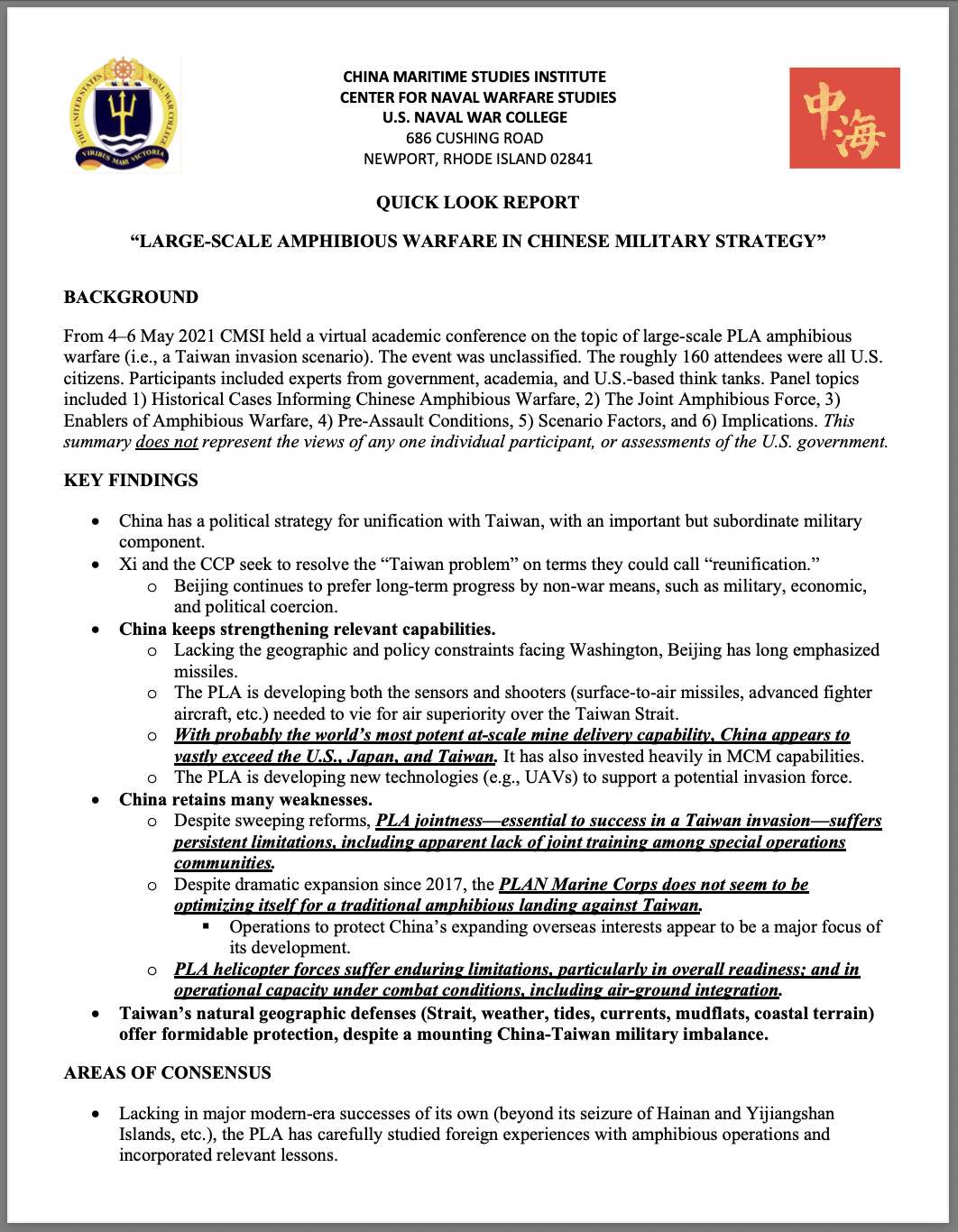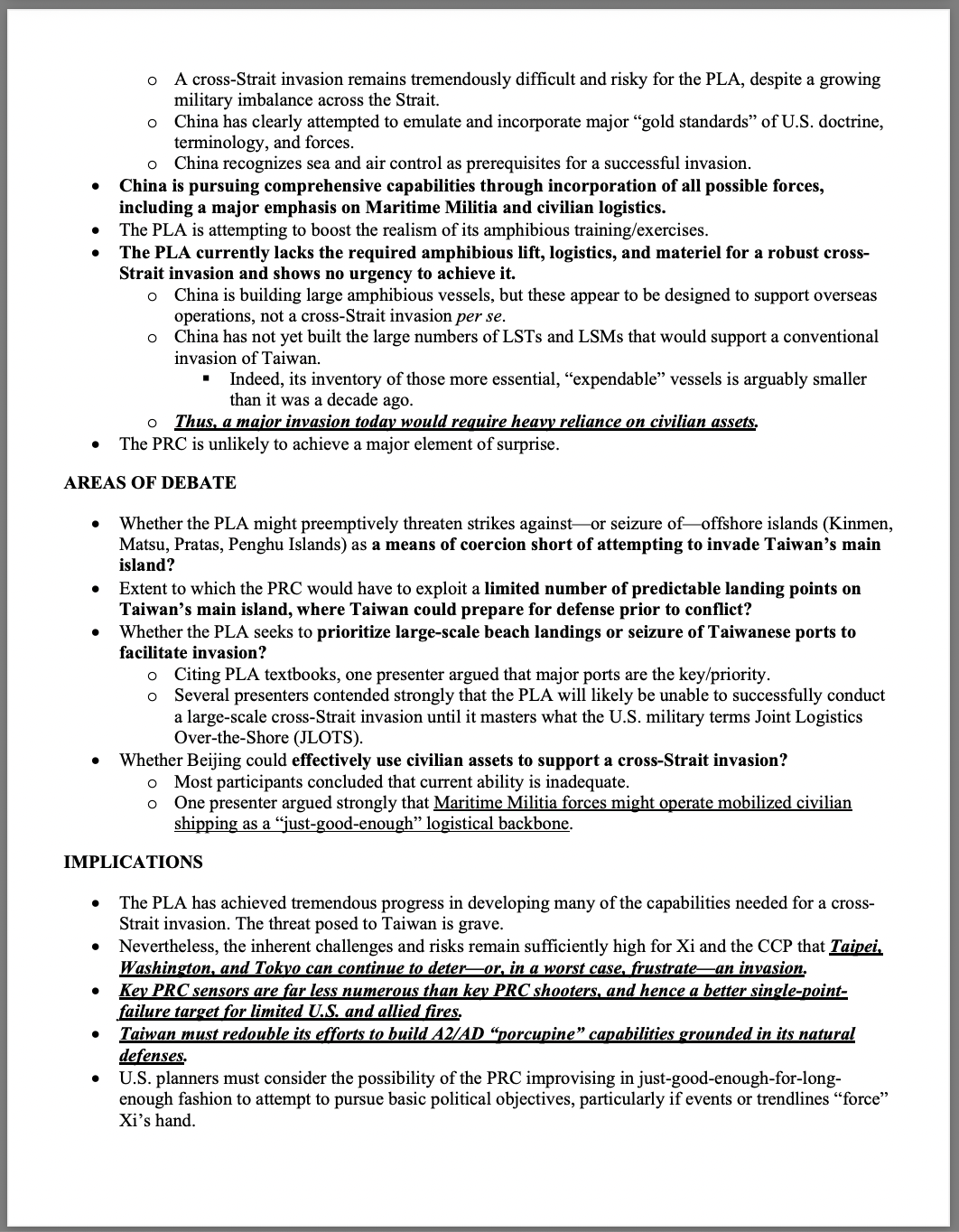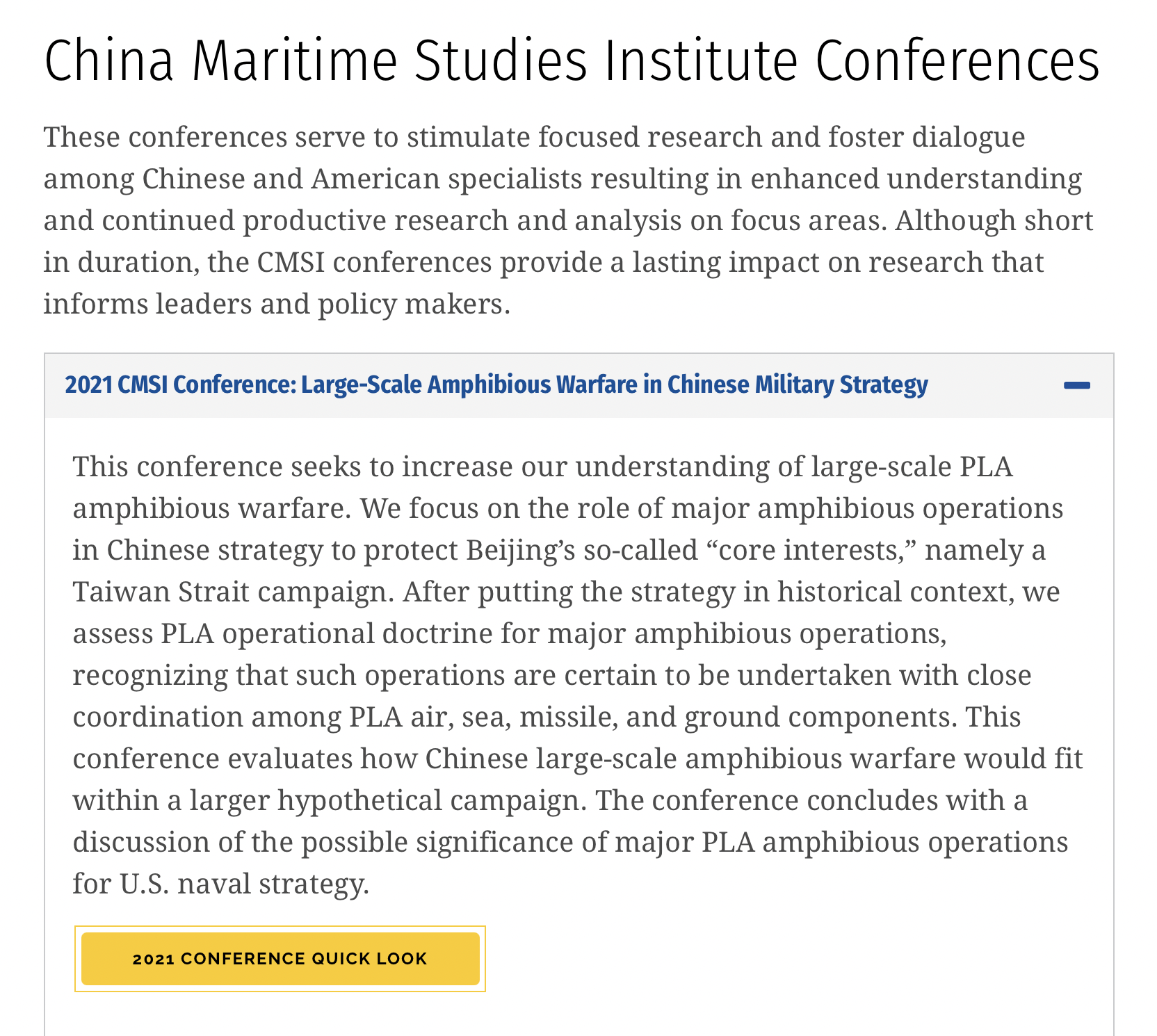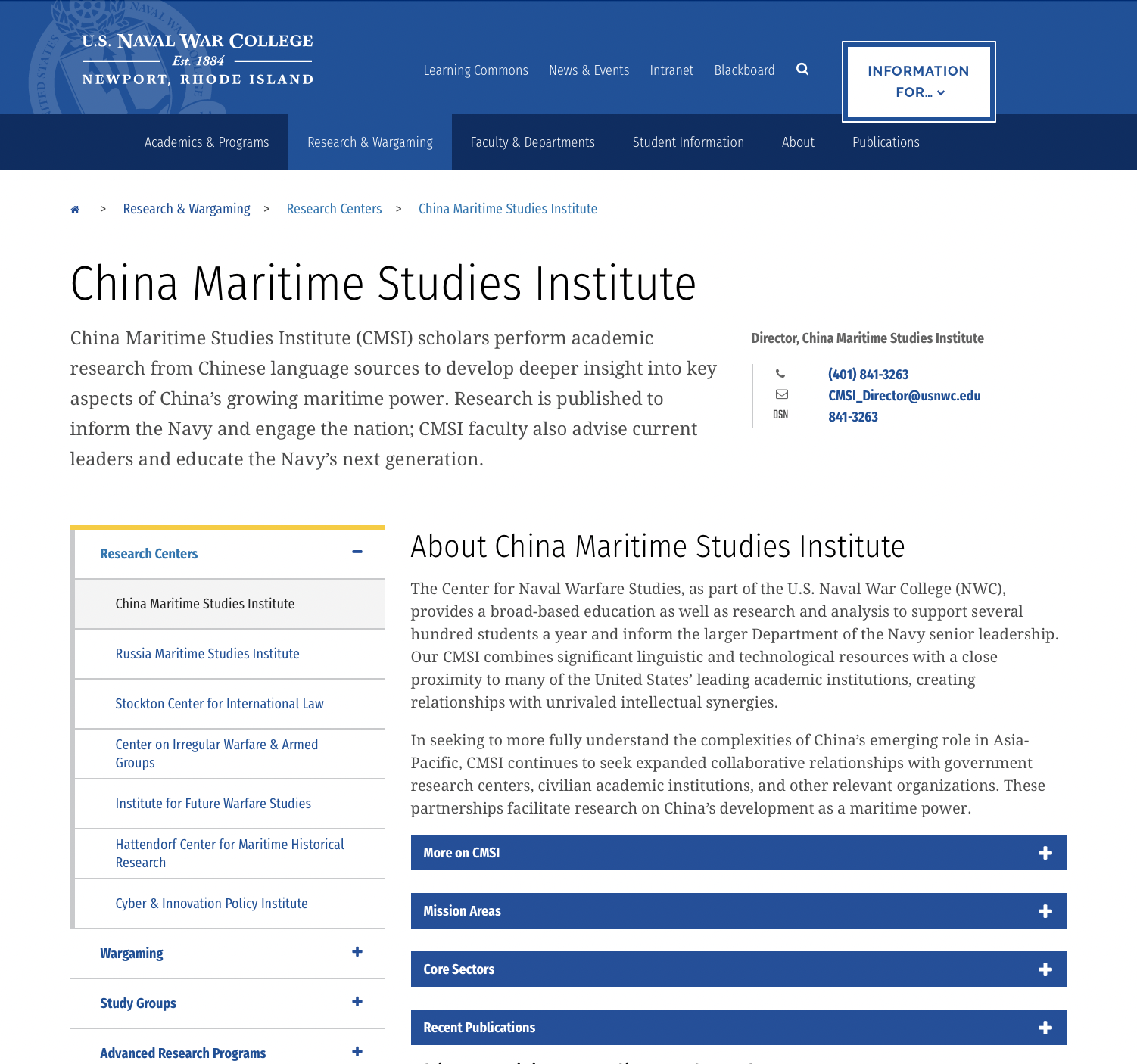Quick Look—CMSI’s 4–6 May 2021 Conference: “Large-Scale Amphibious Warfare in Chinese Military Strategy” (Taiwan Strait campaign focus)
The Naval War College China Maritime Studies Institute (CMSI) has just released the Quick Look summary of its 4–6 May 2021 Conference on “Large-Scale Amphibious Warfare in Chinese Military Strategy.”
***Please kindly note that this Quick Look summary DOES NOT represent the views of any one individual participant, or assessments of the U.S. government.***
This conference seeks to increase our understanding of large-scale PLA amphibious warfare. We focus on the role of major amphibious operations in Chinese strategy to protect Beijing’s so-called “core interests,” namely a Taiwan Strait campaign. After putting the strategy in historical context, we assess PLA operational doctrine for major amphibious operations, recognizing that such operations are certain to be undertaken with close coordination among PLA air, sea, missile, and ground components. This conference evaluates how Chinese large-scale amphibious warfare would fit within a larger hypothetical campaign. The conference concludes with a discussion of the possible significance of major PLA amphibious operations for U.S. naval strategy.
China Maritime Studies Institute, “Large-Scale Amphibious Warfare in Chinese Military Strategy,” Quick Look Conference Summary (Newport, RI: Naval War College, 14 June 2021).
QUICK LOOK REPORT
“LARGE-SCALE AMPHIBIOUS WARFARE IN CHINESE MILITARY STRATEGY”
BACKGROUND
From 4–6 May 2021 CMSI held a virtual academic conference on the topic of large-scale PLA amphibious warfare (i.e., a Taiwan invasion scenario). The event was unclassified. The roughly 160 attendees were all U.S. citizens. Participants included experts from government, academia, and U.S.-based think tanks. Panel topics included 1) Historical Cases Informing Chinese Amphibious Warfare, 2) The Joint Amphibious Force, 3) Enablers of Amphibious Warfare, 4) Pre-Assault Conditions, 5) Scenario Factors, and 6) Implications. This summary does not represent the views of any one individual participant, or assessments of the U.S. government.
KEY FINDINGS
- China has a political strategy for unification with Taiwan, with an important but subordinate military component.
- Xi and the CCP seek to resolve the “Taiwan problem” on terms they could call “reunification.”
- Beijing continues to prefer long-term progress by non-war means, such as military, economic, and political coercion.
- China keeps strengthening relevant capabilities.
- Lacking the geographic and policy constraints facing Washington, Beijing has long emphasized missiles.
- The PLA is developing both the sensors and shooters (surface-to-air missiles, advanced fighter aircraft, etc.) needed to vie for air superiority over the Taiwan Strait.
- With probably the world’s most potent at-scale mine delivery capability, China appears to vastly exceed the U.S., Japan, and Taiwan. It has also invested heavily in MCM capabilities.
- The PLA is developing new technologies (e.g., UAVs) to support a potential invasion force.
- China retains many weaknesses.
- Despite sweeping reforms, PLA jointness—essential to success in a Taiwan invasion—suffers persistent limitations, including apparent lack of joint training among special operations communities.
- Despite dramatic expansion since 2017, the PLAN Marine Corps does not seem to be optimizing itself for a traditional amphibious landing against Taiwan.
- Operations to protect China’s expanding overseas interests appear to be a major focus of its development.
- PLA helicopter forces suffer enduring limitations, particularly in overall readiness; and in operational capacity under combat conditions, including air-ground integration.
- Taiwan’s natural geographic defenses (Strait, weather, tides, currents, mudflats, coastal terrain) offer formidable protection, despite a mounting China-Taiwan military imbalance.
AREAS OF CONSENSUS
- Lacking in major modern-era successes of its own (beyond its seizure of Hainan and Yijiangshan Islands, etc.), the PLA has carefully studied foreign experiences with amphibious operations and incorporated relevant lessons.
- A cross-Strait invasion remains tremendously difficult and risky for the PLA, despite a growing military imbalance across the Strait.
- China has clearly attempted to emulate and incorporate major “gold standards” of U.S. doctrine, terminology, and forces.
- China recognizes sea and air control as prerequisites for a successful invasion.
- China is pursuing comprehensive capabilities through incorporation of all possible forces, including a major emphasis on Maritime Militia and civilian logistics.
- The PLA is attempting to boost the realism of its amphibious training/exercises.
- The PLA currently lacks the required amphibious lift, logistics, and materiel for a robust cross-Strait invasion and shows no urgency to achieve it.
- China is building large amphibious vessels, but these appear to be designed to support overseas operations, not a cross-Strait invasion per se.
- China has not yet built the large numbers of LSTs and LSMs that would support a conventional invasion of Taiwan.
- Indeed, its inventory of those more essential, “expendable” vessels is arguably smaller than it was a decade ago.
- Thus, a major invasion today would require heavy reliance on civilian assets.
- The PRC is unlikely to achieve a major element of surprise.
AREAS OF DEBATE
- Whether the PLA might preemptively threaten strikes against—or seizure of—offshore islands (Kinmen, Matsu, Pratas, Penghu Islands) as a means of coercion short of attempting to invade Taiwan’s main island?
- Extent to which the PRC would have to exploit a limited number of predictable landing points on Taiwan’s main island, where Taiwan could prepare for defense prior to conflict?
- Whether the PLA seeks to prioritize large-scale beach landings or seizure of Taiwanese ports to facilitate invasion?
- Citing PLA textbooks, one presenter argued that major ports are the key/priority.
- Several presenters contended strongly that the PLA will likely be unable to successfully conduct a large-scale cross-Strait invasion until it masters what the U.S. military terms Joint Logistics Over-the-Shore (JLOTS).
- Whether Beijing could effectively use civilian assets to support a cross-Strait invasion?
- Most participants concluded that current ability is inadequate.
- One presenter argued strongly that Maritime Militia forces might operate mobilized civilian shipping as a “just-good-enough” logistical backbone.
IMPLICATIONS
- The PLA has achieved tremendous progress in developing many of the capabilities needed for a cross-Strait invasion. The threat posed to Taiwan is grave.
- Nevertheless, the inherent challenges and risks remain sufficiently high for Xi and the CCP that Taipei, Washington, and Tokyo can continue to deter—or, in a worst case, frustrate—an invasion.
- Key PRC sensors are far less numerous than key PRC shooters, and hence a better single-point-failure target for limited U.S. and allied fires.
- Taiwan must redouble its efforts to build A2/AD “porcupine” capabilities grounded in its natural defenses.
- U.S. planners must consider the possibility of the PRC improvising in just-good-enough-for-long-enough fashion to attempt to pursue basic political objectives, particularly if events or trendlines “force” Xi’s hand.









































